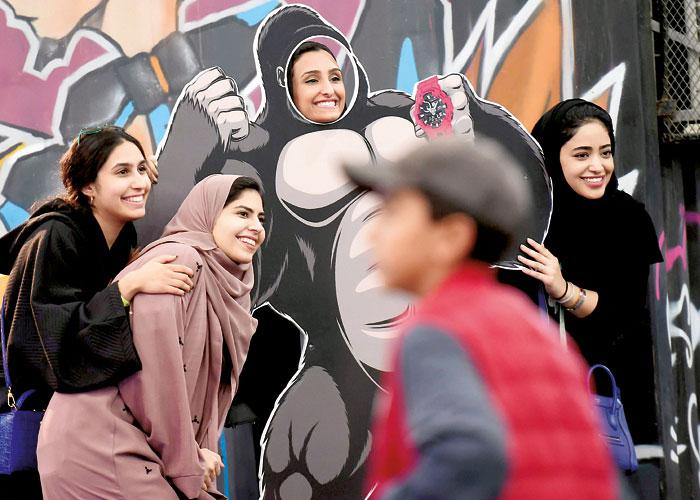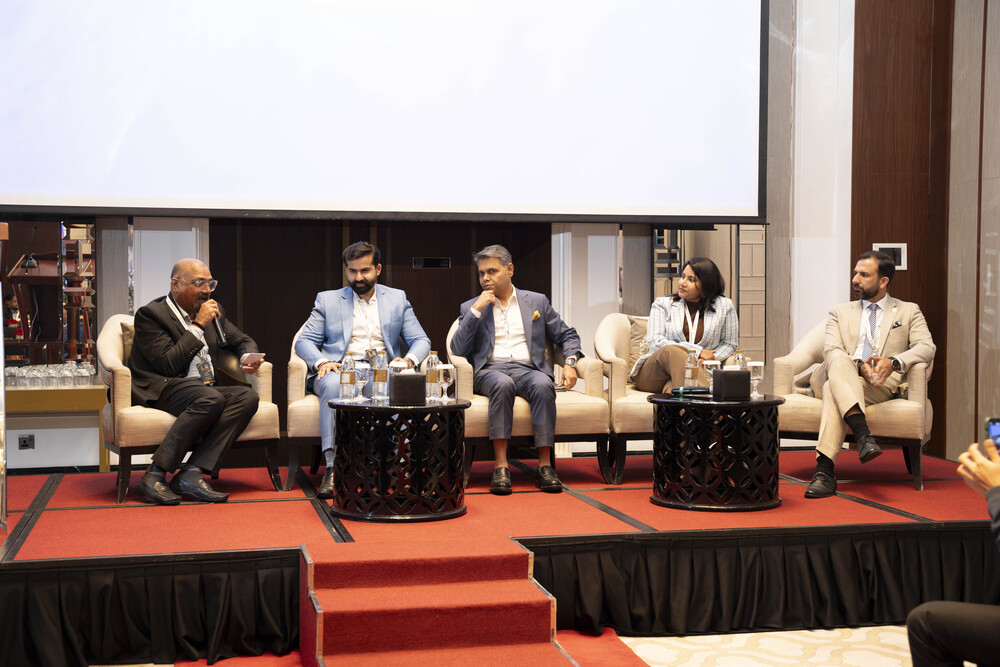What are the key characteristics of today’s Saudi youth that a brand needs to be aware of?
Saleh Lzeik. 70% of the population is under the age of 30 – you’re looking at a nation that is almost entirely a youth segment, and that just shifts the whole paradigm for any brand. Now, this youth segment is not different from the rest of the world, except for a few ways in which they consume and create content. For example, digital device penetration is at 198%, which means that every single person owns at least two devices and is constantly exposed to some kind of content. They’re also very well [informed] and the majority is either bilingual or even trilingual. So, they not only consume content that is relevant to the region, but they’re also aware of the influence that comes from Western and Eastern Asian nations – and that is a very unique feature. In addition, they have a very high purchase power and a very beautiful hybrid [culture] where everyone is well-rooted yet modernized. And because we’d spent so much time before this openness hit, when entertainment was limited to what you could access through your device, I think that’s going to only elevate the level of choices that they’ll be looking for, having higher and higher standards.
Mustafa Zaatari. Cultural diversity is something that we have to consider as well. How tech-savvy they are will vary depending on where they are in the country. For example, a similar age group in the main cities is more tech-savvy and has different behaviors – entrepreneurs, content creators – than in more rural areas where being tech-savvy simply means having a TikTok account. Their focus on education and entrepreneurship is another important aspect. And we’ve started to see the rise of social consciousness. 62 to 63% of customers will either boycott or recommend a brand depending on its purpose and values.
Sara Faisal. The younger Saudis have a unique ability to adapt to and accept changes quickly, and what’s also unique is that their modernity is tied to the traditional culture. They have not forgotten their identity and where they come from – on the contrary, they are very proud of who they are, of their language, etc. They’re bridging the gap between traditions and what’s on trend around the world. This has created a new society and a new target audience. A clear example is Al Ula, a very traditional and ancient place where you can also have a huge DJ party that everyone will attend. And what’s nice is that the population is quite accepting of that.
Besides, these changes are not only internal or for a local target audience. Saudi Arabia was able to put itself on the global map in a very short time, and that in itself is an accomplishment.
What about young Saudi women in particular?
S.F. We were actually waiting for the changes – the ability to drive, the overall rights that we’ve received, and how the government is pushing for us to be in the workforce and in higher positions. Now, we have to adapt to working full-time and being a mother at the same time, which is quite challenging. But it will get easier over time. Young women are much more ambitious, looking to prove themselves.
How would you advise a brand to approach this youth?
M.Z. Be creative, be brave, and deliver a slap: simple, loud, on the apex of things, and persuasive. The worst thing you can do is to be safe. Don’t be safe. Be odd, be unique, be strange. People will either like you or dislike you, but there will be a clear cut between the two, which is good for business. I have a word that encompasses all that needs to be done: ELEAP – empower, especially young creators; local creativity; entertain; authenticity; and personalization. If you follow that, you cannot miss it.
Also, try to provide something beyond the price – everybody is on discount these days, so if your value is price, you’re not in a good place. And most importantly, create a seamless checkout because if you don’t do so, guilt will kick in very fast, and most likely, they’re not going to make the purchase.
S.F. Entertainment is critical. You have to think about the experience, the creative concept, and how to engage the younger generation – not having something that may seem fully educational. Whether it’s a brand, a game, or an event, it has to be interactive in a way that has that entertainment element. And do not assume. The key is to understand the cultural aspect, the trends, and the emotional and rational needs. So, conduct in-depth research before going in because Saudi youth do tend to come with different preferences and cultural nuances. And it’s all about the trends. Where are they now? What do they prefer now?
Some brands come in with the assumption that whatever worked in the UAE would work in Saudi Arabia; but, although they’re very similar countries in terms of culture, they are very different when it comes to audiences, just for the mere fact that the UAE has only one million UAE citizens while Saudi Arabia has 18 million Saudi citizens with different aspects and different backgrounds.; just try to research to fully comprehend the local culture.
S.L. Having someone in the team, a physical person who represents the age groups or the audience segment that you’re targeting, is critical. If you really know whom you’re targeting and get someone on board who is from that audience group, you’re going to get far.
What brands would you give as examples of how to connect with the young Saudi audience the right way?
S.F. Delivery mobile applications like Hunger Station and Ninja are doing a very good job. Sports brands like Nike as well. They are following the trends; they choose their channels wisely. For example, Hunger Station uses TikTok and game streamers, which they know have a lot of target audiences that they want to reach and give them exposure quickly. Gamers and streamers are a huge segment and have been neglected for a long time. 377 million people identify themselves as gamers in the MENA market. In the next five years, it will be a must to consider them.
S.L. STC has developed guidelines on how to communicate since they launched their rebrand, and they’re absolutely hitting the nail on the head. Globally, McDonald’s recently localized their golden arches campaign into Saudi form. Nike does not promote Nike products in Saudi Arabia the same way they promote them in the States, even though it’s the same products. They get local talents and local phrases, and they’re doing it very well.
M.Z. You can look at ToYou because I think we actually communicate in a way that people love. We’re creating stuff that brands shouldn’t create, and our engagement is through the roof. STC did a stellar job breaking a mold that they’ve been stuck in for over 20 years. Another local example is Shawarmer, a restaurant that just tore down the guidebook on advertising and does whatever they think they need to do.
What channels and platforms does a brand need to be on to reach Saudi youngsters today and what role can traditional media play?
S.L. If you’re looking at reaching a very high segment through a government or corporatist approach, Twitter is the way to go. On a more business end, LinkedIn is getting a lot of traction because it’s kind of a status reveal on where you sit on your career path – given that we’re also going through a phase where everyone wants to start their own business and be a startup owner or a CEO/ founder. Snap is huge with influencers, celebrities, and media coverage. Even entities that do not have their own accounts have long-term deals and endorsements with influencers on that platform. TikTok has more of a younger audience, and it’s still getting over the transition from Musical.ly.
And we cannot miss the importance of Google and YouTube, which has incredible records – some of the biggest YouTube non-Arabic-speaking channels across the globe get the most views from Arabic-speaking audiences, specifically from Saudi Arabia. Someone wanting to excel as a content creator will go to long-form and horizontal on YouTube.
Any channel mix for any marketer needs maybe not to use all of these channels but at least consider them. As for ‘traditional’ media, it’s just another media mix tool that you might use if you want to reach a specific audience segment. Everyone easily has access to social and digital platforms, but traditional media has prestige, conveying the message that “I’m a brand that can afford to be here.”
M.Z. You cannot generalize or it will most probably dilute the results of your campaign. A digital campaign nationwide will usually see a very big drop in terms of conversion or engagement in rural areas where outdoors will work best, whereas, in cities, outdoors might fail, for example.
The only advice I would give is to have a very clear segregation of what you need to do and what the objective is from an ROI point of view. It really depends on what you’re trying to achieve. Branding? Awareness? Conversion? If you want results, you’re better off with pro- grammatic, affiliate programs for example, etc. Social media will back it up, but you cannot bet all your money on it. You cannot simply choose a platform like TikTok just because it’s on the rise. Twitter is great for opening discussion and building awareness, but you can’t expect to make unbelievable sales out of it. Conversion is simply not there, for industries like ours at least. It will always be a combination. During Ramadan, for example, if you don’t go traditional, digital will not work; there are two channels you’ll need to be on: Shahid and MBC, and that’s it. Everything else is a support system. Outside of Ramadan, it’s the opposite; digital becomes prominent. Content and context will impact whatever decision you need to take.






